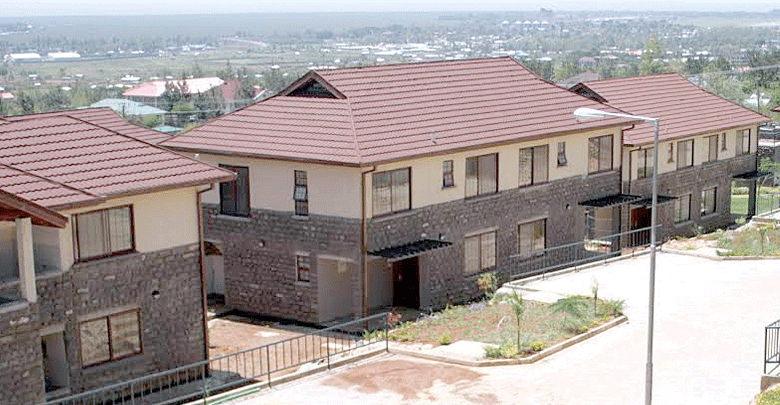Why you’ll sweat before renting a bedsitter in Kisumu

The real estate sector in Kisumu has continued to experience a significant growth with notable developments coming up recently.
The lakeside city boasts of a fast-growing real estate industry with vast developments sprouting in the past few years, especially in the outskirts of the Central Business District (CBD).
Rapid development of residential houses has been witnessed in the superb estates of the town, such as Milimani, Migosi, Lolwe, Mamboleo, Tom Mboya and Riat hills, which are mainly overcrowded with middle and high-end residential apartments. In view of the noteworthy growth, real estate players are seeing an imbalanced housing situation.
West Kenya Real Estate managing director Benard Onyango says a lot of new developments seem to have focused on two and three-bedroom apartments, leaving a gap in provision of other affordable housing segments.
According to Onyango, Kisumu town is experiencing an influx of two-bedroom apartments, creating disparity in the provision of other housing components, such as one bedroom houses and bedsitters.
“There seems to be an oversupply of two bedroom apartments in Kisumu. This does not mean that those looking for two bedroom apartments are not matching the existing supply, but compared to other units, such as single rooms, bedsitters or three bedrooms, two bedroom seem to be more.
The result is high demand for one bedroom and bedsitters,” Onyango explains.
Consequently, he says there is still room for residential flats in Kisumu, but developers should shift focus to putting up affordable housing units to bridge the deficit, especially for one-bedroom houses whose demand is on the rise.
Affordable housing deficit
The proprietor points out that prospective investors have the opportunity to tap into the existing market gap by building purely one-bedroom apartments with a few bedsitters.
“More people are moving into constructing residential units, especially three bedroom bungalow houses,” he says.
Onyango states that despite its notable real estate developments, Kisumu is yet to realise the affordable housing agenda, noting that the lakeside town lags behind in terms of affordable housing compared to Nairobi and Mombasa cities.
“As much as we have witnessed massive demolitions by the county government to pave way for affordable housing projects, not many projects have been completed to meet the affordable housing agenda.
Nairobi has already completed housing projects in this segment,” he states.
He says skyrocketing land prices within the Kisumu town could derail the efforts to come up with the low-cost homes and residential apartments.
Tom and Company agencies Limited managing director Tom Agumbi says recent mushrooming of residential apartments in the town is a good gesture towards addressing the problem of housing shortages, but stresses the need to strike a balance in the sector.
He agrees that there are huge opportunities in low-cost housing, which potential developers in Kisumu should be keen to exploit going forward.
He regrets that middle and low income earners, who apparently constitute a bigger population of the town have been ignored.
Agumbi points out that notable high-end developments have sprang up up lately, especially on the outskirts of the town, with very little to take care of the low income earners.
“We need concerted effort by sector stakeholders and government towards addressing the real problem of low-cost housing shortage here in Kisumu,” he says.
According to the entrepreneur, developers should invest majorly in houses whose value range between Sh2.9 million and Sh3 million to accommodate the majority middle class buyers.
Daniel Ogutu, a developer in Kisumu says the grandeur lifestyle associated with the Luo culture, could be influencing this peculiar scenario.
“It is all about tenant preference. People here prefer spacious houses, especially those with families,” he says. This does not mean that there is not demand for affordable housing.
The price rance for one-bedroom apartments is Sh10,000 to Sh 15,000 in the middle-income estates and between Sh20,000 and Sh25,000 in high end estates.
Onyango points at high land prices within the town as a hindrance for the realisation of affordable housing in Kisumu.
The realtors are at the same time concerned over zoning issue as one of the drawbacks impeding the growth of the real estate industry in the town.
He points out that Kisumu town is characterised by uneven developments in residential houses.
For instance, he says there are residential areas, which have a mix of apartments and detached and semi-detached houses.
“In my view, zoning remains a big problem for property establishment in Kisumu. The planning department should move with speed to fix this issue so that future developments are not mixed up,” he states.
Nonetheless, the property agent foresees a further growth particularly in the residential housing segment, saying more developers are already lining up seeking for a chance to develop such projects.
Viable investment opportunity
According to a 2018 survey by Cytonn Investments on Kisumu, the mid-end residential sector market in the town offers investors a viable investment opportunity.
The report indicates that the mid-end residential market outperformed the high-end residential sector recording a total return of 9.0 per cent, 1.1 per cent points higher than high-end apartments.
This is attributable to higher price appreciation at 3.6 per cent, compared to mid-end at 2.4 per cent due to high uptake at 23.4 per cent.
“The segment recorded an annual uptake of 23.4 per cent, higher than the high-end segment at 16.1 per cent, which is attributable to mid-end apartments’ affordability as they are 29.4 per cent cheaper than the high-end segment,” the report.
Kisumu’s mid-end segment consists of estates, such as Kibos, Kanyakwar and Mamboleo, which are characterised by both high-rise and low-density houses mainly for the middle-class population of the city.
Houses in this segment have average price points ranging between Sh 6.3 million and Sh 7.6 million.
On the other hand, the high-end comprises prime suburbs estates of the town, such as Milimani, Migosi, Lolwe, Tom Mboya and Riat hills mainly overcrowded with high rise apartments. Houses in this segment have price points of between Sh11.2 million and Sh14.3 million.














